A little drizzle didn’t diminish my enjoyment of Sunday’s Literary Walk of old Calgary hosted by the Creative Nonfiction Collective Society to wrap up their 10th anniversary conference weekend. Here’s writer Shaun Hunter talking about Calgary’s near-forgotten painter and author, William S. Bates, and his connection to the Grain Exchange Building (1909), now the home of Freehand Books. 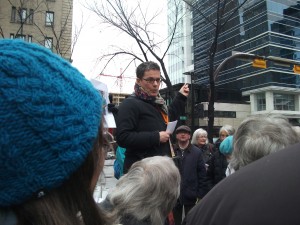
After the walk, we warmed up in the James Joyce pub.
Lots of fun, companionship and laughs at our Arthur Ellis Short-list announcement event at Owl’s Nest Bookstore on April 24th.
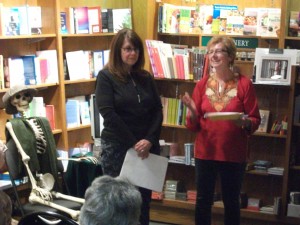
A bonus was having one of our readers – Axel Howerton – make the short list for Best First Novel.
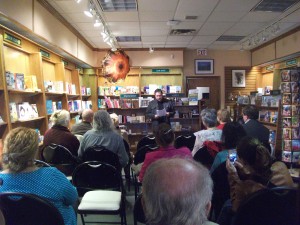
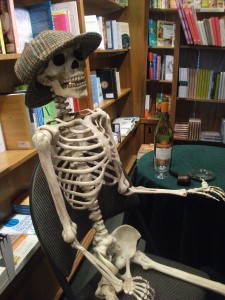
|
||||||||||||||
|
||||||||||||||
My novel-in-progress, Ten Days in Summer, is a finalist in The Sandy Writing Contest, Thriller/Suspense/Mystery category. Winners will be announced at the Crested Butte Writers Conference in June. I wish I could be there.  I feel especially good about this because Sandy was the name of my family dog.
I feel especially good about this because Sandy was the name of my family dog.
Good News. My long short story “Pandemic” was a finalist in the December 2013 Glimmer Train Fiction Open Contest. “Pandemic” was inspired by my trip to Italy five years ago. I wrote the story mentally for several years before committing it to computer screen, seeking feedback, revising and sending it out. Many thanks to the following people, who read all or part of the manuscript: Brian Brennan, Barb Howard, Shaun Hunter, Lee Kvern, Marilyn Letts and Deborah Willis.
Yikes. I haven’t written a blog post since last August. What have I been doing with my time?
1. Writing:
I finished my novel, Ten Days in Summer, the sequel to Deadly Fall, and am waiting for word from publishers.
While waiting for word, I’m revising a non-mystery novel that is into its fourth draft.
I polished a 12,000 word short story I wrote a few years ago and sent it to three contests. It made the finals in the Glimmer Train Fiction Open Contest. Within the next few weeks, I should hear how the story fares in the other two.
2. Travel:
In November, Will and I spent 16 days in Hawaii, on two islands we hadn’t visited before — Oahu (Waikiki-Honolulu) and Big Island. We loved them both.
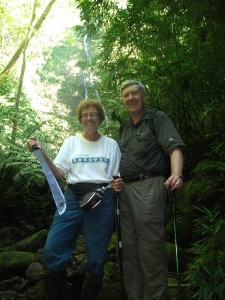
Highlights included a jungle hike (pictured here), swimming with sea turtles (usually not on purpose – to my surprise they appeared beside me on busy Waikiki beach), hiking Koko Head – the steepest hike in my life, Pearl Harbour; on Big Island driving to the summit of Mauna Kea volcano for an astronomical tour and viewing stars and the moon through a powerful telescope, hiking Kilauea Iki Crater backdropped by a spewing active volcano; beaches, pools, strolling the streets after dark without a sweater and good food.
In Calgary, memories of warm Hawaii quickly faded this cold, snowy winter. In late February, Will and I escaped for a week in Cancun, Mexico. Sunshine. Thirty-degree highs every day. Mostly we relaxed on the beach and by the pool, but we included two full day outings. One was was a ferry ride to nearby Isla Mujeres (Island of Women), where we rented a golf cart, saw the whole island in three hours and finished with a swim in shallow, calm Playa Norte. The other excursion was a bus tour to the Mayan ruins of Chichen Itza, which we’ve wanted to see since our first trip to Mexico some years ago. It was a long drive through jungle, but the ruins were awesome. I’d love to return to spend more time there.
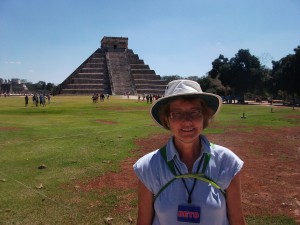
Despite the hat I wore constantly on the trip and covering up on the beach, I still have my tan.
3. Teaching
Since September, I’ve been teaching A Novel Approach at the Alexandra Writers Centre. The class runs every second week and ends in June. It’s been a challenge for me to keep up with the students. I hope they’ve learned as much as have and go on to finish their terrific books.
The weekend after I returned from Mexico, I taught a two day intensive workshop on Novel Revision. It was inspiring and great learning for me, too, if a tad exhausting.
4. Writing related activities
A surprisingly fun activity was working the AWCS casino in December. Will and I took a night shift in the counting room and somehow managed to stay up until 3:00 AM. We really enjoyed hanging out with other AWCS members and getting a glimpse of casino activity.
I organized the Crime Writers of Canada and Calgary Crime Writers tables at the Calgary Public Library Writers Weekend on February 1st. I spent the day at interesting sessions on publishing and writing humour in between my shifts (wo)manning the table.
5. All the rest of life.
Family. Reading. Walks in city parks. Friends. Snoe shoe trips to Kananaskis, Banff and Lake Louise. Zumba & Fit and Fab at the gym.
Life away from the blog has been busy and good, but I promise not to wait this long before I post again.
Arthur Ellis Awards for Excellence in Canadian Writing
Short-list Announcement Party
April 24, 2014 7-9 PM
Owl’s Nest Bookstore
Britannia Shopping Centre at Elbow Drive and 49th Avenue.
815A 49th Avenue SW
Calgary, AB
Crime Writers of Canada members Axel Howerton, Kirk Layton and Darlene Quaife will read from their writing, muse on the theme of ‘short’ and discuss the difference between writing a short story and novel. Music by Alastair Robertson. Emcee Susan Calder. At the end, we’ll reveal the short lists for this year’s Arthur Ellis Awards, Canada’s national mystery and crime writing awards. Winners will be announced at a Toronto banquet in June. Come learn who’s hot in Canadian crime writing.
Light refreshments provided by Owl’s Nest books. Free. Everyone welcome.
For more information contact Owl’s Nest Books 403-287-9557 403-287-9557 or owlsnestbooks@shaw.ca
403-287-9557 or owlsnestbooks@shaw.ca
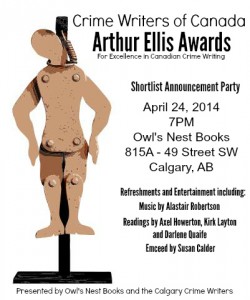
S aturday, 9 November 2013, 2:00pm
aturday, 9 November 2013, 2:00pm
The Mystery of War
Join members of Crime Writers of Canada for an afternoon of readings and reflection
From the innermost struggles of the lone individual through the most intimate of domestic battles and on up to the conflagrations that consume civilizations, War is an enduring fact of human existence. Six Calgary-area crime writers read from their works and reflect on the nature of war, of sacrifice, of history and memory. Readers: Stephen Legault, Linda Kupecek, Jayne Barnard, Darlene Quaife, Sharon Wildwind and Susan Calder. Owl’s Nest Bookstore, Britannia, Calgary.
War and Mystery readings at Owl’s Nest Book Store on Saturday afternoon, Nov 9, in honour of Remembrance Day. Stay tuned for details. I’ll be reading new work.